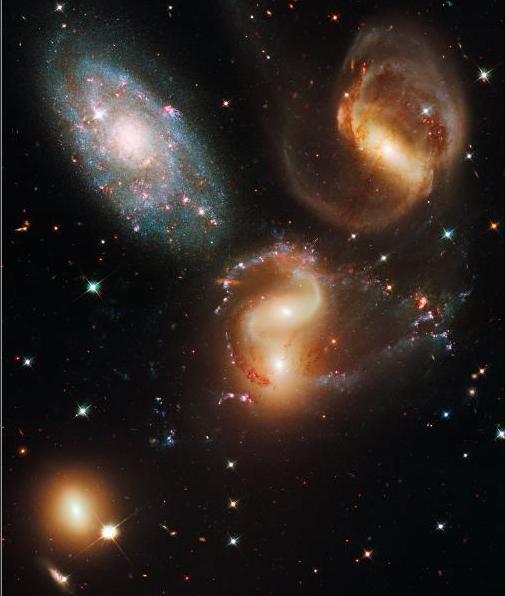A collision between members of a famous quintet of galaxies reveals a selection of star types spanning a wide spectrum of colors and ages - from young blue stars to red aging stars.

This photograph of the Stephen Quintet - a group of galaxies known as the Hixon Compact Group No. 92 - was taken by the Hubble Space Telescope's Wide Field/Planetary Camera No. 3.
The Steven Quintet is a group of five galaxies. The name, in any case, does not correspond to reality because one of the members of the alleged "group", NGC 7320 (top left) is a galaxy that happens to be in the line of sight and is 7 times closer to Earth than the other galaxies.
Three of the galaxies have a distorted shape - elongated spiral arms and long gas tails due to the tides, containing a large number of star clusters, proof of the great proximity between them. This interaction between them ignited a huge wave of star formation in the two central galaxies. This drama takes place against the backdrop of distant galaxies.
The image, taken in infrared light, proves once again the range of frequencies that the new camera observes. The colors change according to the stars, and show that the birth of stars occurred in separate epochs, lasting over hundreds of millions of years. The infrared viewing capability of the camera allows penetration into the dust screens and seeing constellations of stars that cannot be seen in visible light.
NGC 7319, upper right, is a spiral galaxy with a central bar, and well-defined arms that follow 180 degrees behind the bar. The blue spots in the spiral arm at the top of NGC 7319 and the red dots just above and to the right of the nucleus are clusters containing many thousands of stars. Most of the quintet is so far away that even Hubble cannot separate individual stars.
Further, clockwise, the next galaxy appears to contain two cores, but these are actually two galaxies - NGC 7318A and NGC 7318B. These galaxies are surrounded by bright blue clusters of young stars and pink clouds of glowing hydrogen where young stars are forming. These stars are 10 million years old and they did not have time to blow out their primordial cloud. Away from these galaxies, to the right, we see a patch of the intergalactic medium where young stars are formed.
NGC 7317 in the lower left part of the image, is a normal elliptical galaxy that is probably less affected by interactions.
In sharp contrast to these galaxies is the dwarf galaxy NGC 7320 on the upper left. Bursts of star formation are occurring in the galaxy's disc, as seen by the blue and pink dots. In this galaxy, which is much closer to us, Hubble can isolate individual stars. NGC 7320 is 40 million light years from Earth. The other galaxies in the quintet are 290 million light-years away, in the direction of the Pegasus group.
These distant friends are much redder than the nearest galaxy in their line of sight, suggesting that old stars reside in the galactic core. The starlight may also be further redshifted by the gas blown away during the collisions.
The group was observed by Edward Stephen in 1877, and is considered the first compact group discovered (four out of the five of course). Planetary Camera #3 photographed Steven's quintet in July and August 2009 and the image is a combination of photography with blue, green and infrared filters, as well as the ionized gas emission was observed.
Credit: NASA, ESA, and the Hubble SM4 ERO Team
More of the topic in Hayadan:
- The Dance of the Galaxies - about the Steven Quintet as photographed from the Gemini Telescope in Hawaii,2004
- The new images of Hubble: Part I - The Butterfly Nebula
- The new images of the Hubble: Part II - the Carina Nebula
- The new images of Hubble: Part C - the globular cluster Omega Catenauri
- Prof. Mario Livio - today we have in Hubble the largest collection of working instruments ever

7 תגובות
A. Ben-Ner:
In principle - the deduction that the more distant galaxies are shifted more towards the red direction is correct, but I would not make a physical connection between this fact and the image.
The image was taken in infrared light and the fact that we see it is the result of an artificial determination of the translation of the wavelengths.
It is probable, however, that this artificial coloring does preserve the order of the wavelengths.
Regarding the red color of the distant galaxies and the blue color of the nearby galaxy. It is possible that, in addition to the reasons stated in the article,
Also their great distance, 7 times the distance of the blue galaxy, contributes to the redshift, according to Hubble's law?
Thanks for the answer, I and God are grateful.
The pictures are spectacular, the whole last series...
I didn't check, but the answer is probably in the question. Not all galaxies, (or at least the visible part of them) are the same size.
And what about my question?! The anonymous blesser gets a response and my legitimate question ignored??
What will the Creator of the world say 🙂
To Anonymous, I understand you meant Steven, indeed, he deserves all the credit for the interesting discovery.
unbelievable!
a question,
Does NGC 7320 take up similar screen space as the others because it is a dwarf? I would expect that because of the relative proximity it would take up more space...